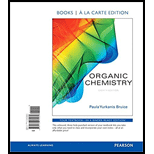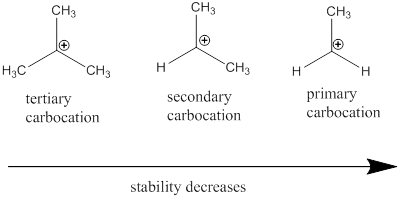
Concept explainers
(a)
Interpretation:
The given set of carbo cations should be ranked from most to least stable.
Concept introduction:
Carbocation: It is carbon ion that bears a positive charge on it.
Leaving group: It is a fragment that leaves from a substrate with a pair of electrons via
Carbocation stability order:

Resonance stabilization: Due to the delocalization of electrons within the molecule the overall energy becomes lower and makes that molecule more stable.
Nucleophile: Nucleophiles are electron rich compounds which donates electrons to electrophilic compounds which results in bond formation.
Nucleophilic nature depends on the negative charge present in the molecule, the solvent in which it present and the electronegativity of the atom.
Electrophile: Electrophiles are electron deficient compounds which accepts electrons from nucleophiles that results in bond formation.
(b)
Interpretation:
The given set of carbo cations should be ranked from most to least stable.
Concept introduction:
Carbocation: It is carbon ion that bears a positive charge on it.
Leaving group: It is a fragment that leaves from a substrate with a pair of electrons via
Carbocation stability order:

Resonance stabilization: Due to the delocalization of electrons within the molecule the overall energy becomes lower and makes that molecule more stable.
Nucleophile: Nucleophiles are electron rich compounds which donates electrons to electrophilic compounds which results in bond formation.
Nucleophilic nature depends on the negative charge present in the molecule, the solvent in which it present and the electronegativity of the atom.
Electrophile: Electrophiles are electron deficient compounds which accepts electrons from nucleophiles that results in bond formation.
Want to see the full answer?
Check out a sample textbook solution
Chapter 6 Solutions
ORGANIC CHEMISTRY (LL)-W/MOD.MASTERING.
- A is a toxin produced by the poisonous seaweed Chlorodesmis fastigiata. (a) Label each alkene that exhibits stereoisomerism as E or Z. (b) Draw a stereoisomer of A that has all Z double bonds.arrow_forwardEleostearic acid is an unsaturated fatty acid obtained from the seeds of the tung oil tree (Aleurites fordii), a deciduous tree native to China. (a) Draw the structure of a stereoisomer that has a higher melting point than eleostearic acid. (b) Draw the structure of a stereoisomer that has a lower melting point.arrow_forwardSuzuki coupling of aryl iodide A and vinylborane B affords compound C, which is converted to D in the presence of aqueous acid. Identify compounds C and D and draw a stepwise mechanism for the conversion of C to D.arrow_forward
- A is a toxin produced by the poisonous seaweed Chlorodesmis fastigiata. (a) Label each alkene that exhibits stereoisomerism as E or Z.arrow_forward(a) Are compounds B–D identical to or an isomer of A? (b) Give the IUPAC name for A.arrow_forwardsusceptible to nucleophilic attack a to b c only a only a and carrow_forward
- When both carbons ortho to the aryl oxygen are not bonded to hydrogen, an allyl aryl ether rearranges to a parasubstituted phenol. Draw a stepwise mechanism for the following reaction, which contains two [3,3] sigmatropicrearrangements.arrow_forwarda. Draw the two chair forms for compound A, being careful to show the stereoisomergiven above. You may use shorthand R in your drawings. Indicate the MAJOR and MINORconformations b. Using curved-arrow convention and the correct chair form of Compound A, show themechanism for the formation of alkene C from Compound A. You may use B: to indicatethe base.arrow_forwardHow is compound A related to compounds B–E? Choose from enantiomers, diastereomers, constitutional isomers, or identical molecules.arrow_forward
- Captopril is a drug used to treat high blood pressure and congestive heart failure. a.Designate each stereogenic center as R or S. b.Draw the enantiomer of captopril. c.What product is formed when captopril is treated with one equivalent of NaH? d.What product is formed when captopril is treated with two equivalents of NaH?arrow_forwardClassify the carbocations as 1°, 2°, or 3°, and rank the carbocations in each group in order of increasing stability.arrow_forwardDraw the major product (with stereochemistry) of the following reaction. Draw only one enantiomer for a racemic mixture.arrow_forward
 ChemistryChemistryISBN:9781305957404Author:Steven S. Zumdahl, Susan A. Zumdahl, Donald J. DeCostePublisher:Cengage Learning
ChemistryChemistryISBN:9781305957404Author:Steven S. Zumdahl, Susan A. Zumdahl, Donald J. DeCostePublisher:Cengage Learning ChemistryChemistryISBN:9781259911156Author:Raymond Chang Dr., Jason Overby ProfessorPublisher:McGraw-Hill Education
ChemistryChemistryISBN:9781259911156Author:Raymond Chang Dr., Jason Overby ProfessorPublisher:McGraw-Hill Education Principles of Instrumental AnalysisChemistryISBN:9781305577213Author:Douglas A. Skoog, F. James Holler, Stanley R. CrouchPublisher:Cengage Learning
Principles of Instrumental AnalysisChemistryISBN:9781305577213Author:Douglas A. Skoog, F. James Holler, Stanley R. CrouchPublisher:Cengage Learning Organic ChemistryChemistryISBN:9780078021558Author:Janice Gorzynski Smith Dr.Publisher:McGraw-Hill Education
Organic ChemistryChemistryISBN:9780078021558Author:Janice Gorzynski Smith Dr.Publisher:McGraw-Hill Education Chemistry: Principles and ReactionsChemistryISBN:9781305079373Author:William L. Masterton, Cecile N. HurleyPublisher:Cengage Learning
Chemistry: Principles and ReactionsChemistryISBN:9781305079373Author:William L. Masterton, Cecile N. HurleyPublisher:Cengage Learning Elementary Principles of Chemical Processes, Bind...ChemistryISBN:9781118431221Author:Richard M. Felder, Ronald W. Rousseau, Lisa G. BullardPublisher:WILEY
Elementary Principles of Chemical Processes, Bind...ChemistryISBN:9781118431221Author:Richard M. Felder, Ronald W. Rousseau, Lisa G. BullardPublisher:WILEY





